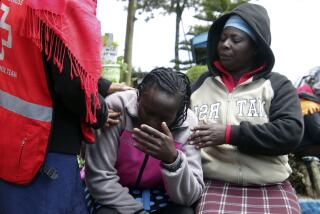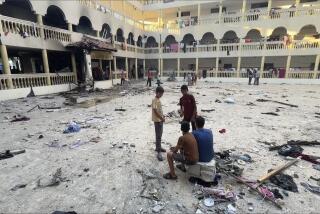Kenyan air force launches strikes against Shabab militants

Soldiers from the Kenya Defence Forces patrol Monday inside the Garissa University College compound that was the scene of last week’s attack by Shabab gunmen, in Garissa, Kenya.
Kenya’s air force launched air strikes Monday on two Shabab camps in the Gedo region of Somalia, the Kenyan Defense Force announced, as parents continued searching morgues for children missing since last week’s attack on a university by the Islamist militant group.
The only killer identified thus far in the massacre has raised fears of a new breed of recruits to the Al Qaeda-linked Somali extremist group: young, bright, well-educated, privileged and Kenyan.
Mohammed Abdirahim Abdullahi, a law student from the University of Nairobi, was the son of a chief in Mandera, northern Kenya – an appointed government representative at village level. The student, who died in the attack after Kenyan forces responded – had gone missing about a year ago.
Students have said the assailants at Garissa University College spoke Kiswahili, one of Kenya’s local languages, to students and one another during Thursday’s attack in which 148 people were killed.
Kenyan authorities have identified the mastermind as a Kenyan Somali, Mohamed Mohamud, who goes by several different names including Dulyadin and Gamadhere.
As Shabab has lost ground in Somalia, it has deepened its roots in neighboring Kenya, analysts have warned.
In the past, Shabab has often targeted poor, jobless young men in Kenya, offering them money and a cellphone to join up, but Abdullahi’s role suggests the group has become more sophisticated in its recruitment of Kenyans, appealing to well-educated, less-impoverished young Kenyan Somalis.
“Now we are seeing more sophisticated recruitment: We see a generation of well-educated young people being recruited,” said Hassan ole Naado, deputy secretary general of the Supreme Council of Kenya Muslims, in an interview Monday. “If you have a well-educated young person going to informal camps, imagine what a powerful recruitment tool that is, because they say, ‘Look at me, I don’t need to be here, but I believe we belong here.’”
Naado said the council, known as Supkem, was planning to have religious scholars analyze Koranic texts and develop counter-narratives to Shabab’s recruitment propaganda, to help to protect vulnerable young people from being radicalized.
Abdullahi has been described as a well-dressed young man, who ran a business in the Somali neighborhood of Eastleigh, Nairobi, while he was studying and enjoyed playing pool with friends. Friends said he showed no outward signs of radicalization at school or the university, according to Kenyan media.
“His arguments were very rational. Even in class, he was very rational. That’s why I’m surprised he could have been radicalized,” a former friend, Dedan Wachira, told Kenya’s Nation newspaper.
Kenyan blogger Yassin Juma reported Sunday that Abdullahi and two other classmates from Wamy High School, a prominent Islamic secondary school in Nairobi, had been radicalized after leaving school. One of them, he said, joined the Islamic State and the other joined Shabab with Abdullahi.
Following Thursday’s attack, photographs of Abdullahi on Facebook showed him shot in the head, lying on the ground.
“I taught this kid. If I did not see his picture, I would never have believed it was him,” Alibash Mohamed wrote on Facebook. Mohamed said on Twitter he taught Abdullahi for two years “and there was nothing like radicalization.”
In another post on Facebook, the teacher said. “I still cannot believe he did it,” adding that Abdullahi was an A student. Others who knew him wrote on Facebook that he was among Kenya’s top 100 high school graduates in 2007.
Analysts called on Kenya’s government to do more to counteract Shabab’s propaganda – but also to ensure that police sweeps in Eastleigh didn’t feed the group’s claims that Somalis aren’t welcome in Kenya.
Kenyan police were strongly criticized for mass round-ups of Somali Kenyans last year, which saw more than 1,000 people arrested and held in Kasarani stadium, dubbed a “concentration camp” by Somali Kenyans.
Naado said Shabab, like other militant groups, was selectively twisting aspects of the Koran to justify killing.
“The government has no choice but to find a way of engaging the community in counter-narratives (to Shabab’s propaganda) and addressing the socioeconomic issues,” Naado said.
“We have returnee ex-combatants in Kenya, young people returning from Al Shabab. Now they’re in hiding. They can’t move freely about because they fear arrest. There’s a need to re-integrate them and reform them. I see them as a very powerful resource, because they form a strong counter-narrative.
“They give the counter-narrative to Al Shabab a face, because they can say, ‘I’ve been there and I’ve come back and this is why I came back.’”
Eastleigh businessman Ahmed Mohammed, a Kenyan Somali, said Shabab was trying to drive a wedge between Kenya’s Christian and Muslim communities by attacking Christians. Mohammed organized a march of Somali Kenyans on Friday to express grief and solidarity over the university attack.
He warned against mass arrests, amid a backlash on social media and among Kenyan politicians over the presence of Somali refugees in Kenya.
“What we normally see is blanket condemnation,” he said. “It’s very counter-productive. This is a community you want to get information from. If you knock on the door of a Somali family at 2 o’clock in the morning and turn their lives upside down, you don’t expect them to give you information,” he said, referring to last year’s arrests.
“We ask the government to make sure police operations are intelligence-led. If they suspect there are terrorist cells, they get in there, do their business and get out.”
robyn.dixon@latimes.com
More to Read
Sign up for Essential California
The most important California stories and recommendations in your inbox every morning.
You may occasionally receive promotional content from the Los Angeles Times.










